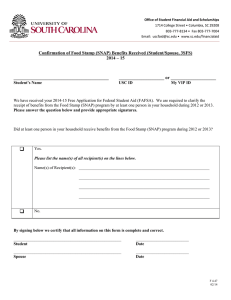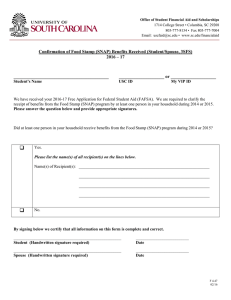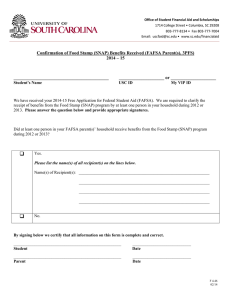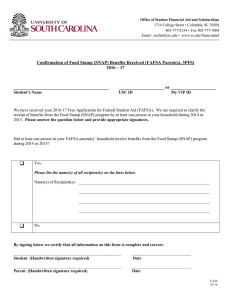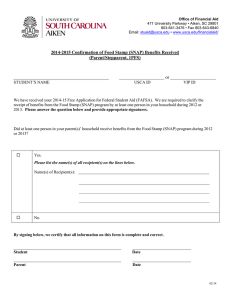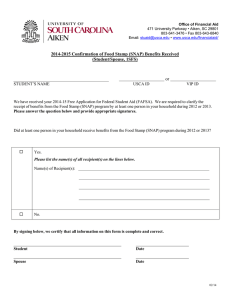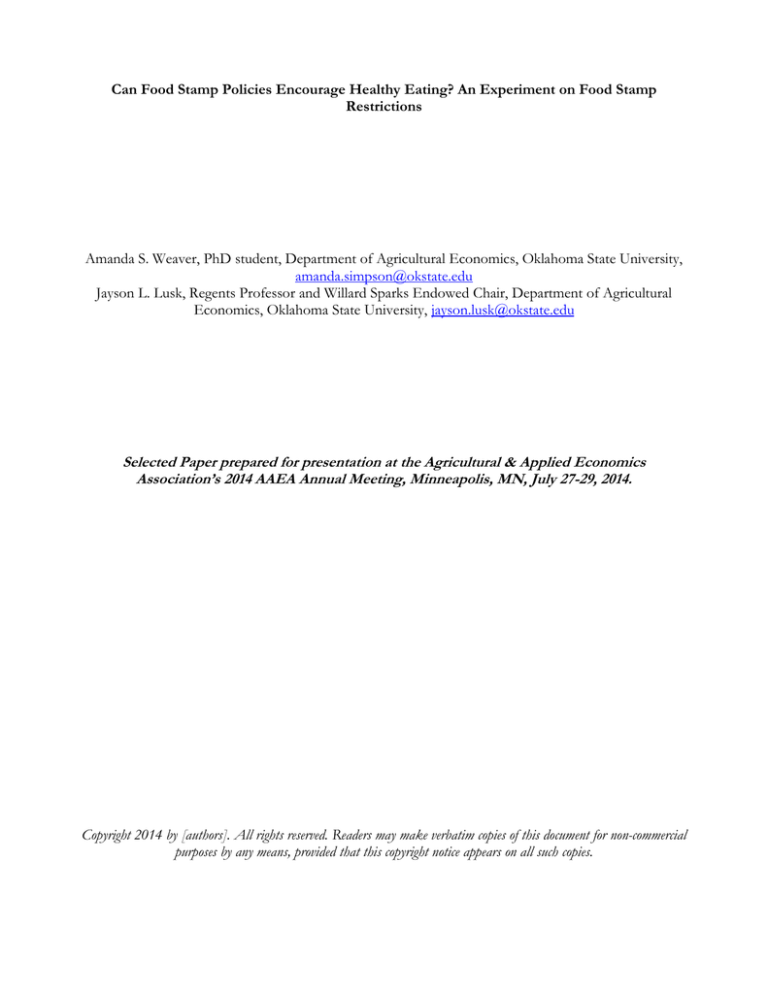
Can Food Stamp Policies Encourage Healthy Eating? An Experiment on Food Stamp
Restrictions
Amanda S. Weaver, PhD student, Department of Agricultural Economics, Oklahoma State University,
amanda.simpson@okstate.edu
Jayson L. Lusk, Regents Professor and Willard Sparks Endowed Chair, Department of Agricultural
Economics, Oklahoma State University, jayson.lusk@okstate.edu
Selected Paper prepared for presentation at the Agricultural & Applied Economics
Association’s 2014 AAEA Annual Meeting, Minneapolis, MN, July 27-29, 2014.
Copyright 2014 by [authors]. All rights reserved. Readers may make verbatim copies of this document for non-commercial
purposes by any means, provided that this copyright notice appears on all such copies.
Introduction
The goal of the food stamp program seems to continue shifting from a goal of putting food on the table
to dictating the healthfulness of what household leaders choose to feed their families due to increasing health
concerns about overconsumption. Certain items like junk food (chips, candy and other sugary snacks) and soft
drinks seem to be the target of restrictive policy suggestions, while others want to incentivize healthy eating
habits by providing additional funds for fruit and vegetable purchases. Some point out that SNAP pays
approximately $2 billion each year for SNAP participants to purchase sugary drinks (Andreyeva et al. 2012;
Shenkin and Jacobson 2010; Barnhill 2011). Andreyeva et al. (2012) suggest that “it would be a good time to
reconsider the program priorities to align public funds with public health” (p. 411). Others have argued that
SNAP benefits should further incentivize the consumption of fruits and vegetables through farmer’s markets
with programs like the Double Value Coupon Program (Wholesome Wave 2012). In another recent study, subsample of SNAP-participating households were tested in a Healthy Incentives Pilot (HIP) program to test if a
30% incentive for purchases of fruit and vegetables would increase consumption, which they found it to increase
by about 20% (Klerman, Bartlett, and Wilde 2014). Despite the significant increase in consumption of fruits and
vegetables, this only brings the average up a quarter of the way to an average recommended in the USDA dietary
guidelines, thus additional or another method entirely could be used to be more effective.
Could changes to SNAP significantly alter consumption patterns to meet dietary guidelines? There are
some conceptual reasons to suggest that soda restrictions may not affect purchases for many SNAP participants.
Going back as far as Southworth (1945), it has been recognized that inframarginal households, the 90% of
households who spend more on food than the SNAP benefit, should, in theory, treat the additional SNAP funds
as an unrestricted transfer of money. For inframarginal households, any change in food expenditures resulting
from SNAP arises through an income effect so long as “the marginal propensity to spend out of food stamps is
equal to the marginal propensity to spend out of cash” (Beatty and Tuttle 2012). That is, a cash transfer should
have the same effect on an inframarginal household as a food stamp transfer of funds.1 Similarly, so long as
SNAP recipients spend more on groceries than their SNAP-benefits, restrictions on soda should have no effect
Empirical research on the Southworth hypothesis is mixed, with some evidence in support (Moffitt 1989; Whitmore 2002)
and some against (Senauer and Young 1986; Levedahl 1995; Breunig and Dasgupta 2005; Breunig and Dasgupta 2002).
Empirical studies that fail to support the hypothesis tend to find that SNAP participants spend more of the benefit on food
than would be predicted by an equivalent cash transfer.
1
since the budget can simply be reallocated between SNAP and non-SNAP dollars to achieve the same
consumption bundle as before the restriction. Despite this conceptual reasoning, a soda restriction might serve as
a signaling effect, or discourage consumption, in much the same way that authors have argued that SNAP
benefits might increase food purchases beyond what might be expected from an income effect (Beatty and Tuttle
2012). The objective of this research is to construct a relatively simple economic environment in which some of
these conjectures can be tested.
This paper addresses the healthfulness of dietary choices made by the poor, and a number of studies
have offered conjectures for why poor households often make relatively unhealthy choices. Affordability of
healthy options is one factor believed to contribute to overweight and obesity among the poor (Mullally et al.
2008; Eisenmann et al. 2011; Drewnowski and Specter 2004; Drewnowski and Darmon 2005; Drewnowski
2004), (also see evidence that argues against this premise when cost is measured on a per weight basis, e.g., Davis
and Carlson (2012)). Others have pointed to accessibility, finding correlations between number of fast food
restaurants and obesity (Cummins and Macintyre 2006; Li et al. 2009). Binkley (2010) argues that “poor food
choice by low-income individuals is just one instance of a more general pattern” (p. 973), and suggests that lower
income households tend to have a higher discount rate and thus place a lower value on the future health.
Another study found SNAP participating households had lower diet quality than those who are eligible to
participate and choose not to (Leung et al. 2012). Consistent with this observation, (Stewart, Blisard, and Jolliffe
2003) found that if the average low income household was given an additional income of $1,000, they would not
change their fruit and vegetable consumption significantly. However, food activist Michael Pollan pushes fruit
and vegetable consumption nonetheless by recommending that, “Food-stamp debit cards should double in value
whenever swiped at a farmers’ markets — all of which, by the way, need to be equipped with the Electronic
Benefit Transfer card readers that supermarkets already have” (2008). Food movements advocated by figures like
Pollan are constantly pushing for change in the food markets by government intervention, but the effects of such
changes may not be fully understood. If increasing income via SNAP benefits does not encourage low income
households to consume healthier foods and more restrictions results in fewer participants, changing unhealthy
habits in this socioeconomic class may require a different method rather than additional restrictions.
Methods and Procedures
A framed field experiment was conducted, in which consumption choices were observed in five treatments.
Respondents made non-hypothetical choices for items to be consumed in a meal to be consumed on site. Menu
items displayed in the front of the room varied in terms of price and healthfulness, but across all five menus, the
price and menu items are the same. Participants can use their participation fee to purchase menu items (the entire
show-up fee does not have to be spent) in addition to coupons or certificates that vary across treatments in a way
to mimic the current SNAP program and potential policies that restrict its use. Table 1 lists the five different
treatments used in the experiment.
Table 1. Treatments Utilized in Experiment
Treatment Participation fee
Certificate
1
$10
None (control)
2
$10
additional $2 dollars added to show-up fee
3
$10
$2 certificate only good for menu items
4
$10
$2 certificate only good for menu items; certificate cannot be used to pay for soda
5
$10
$2 certificate only good for fruits/vegetables on menu
This means that each menu would have a different wallet or income level, basically. In treatment 2, they
would have $12 cash instead of just $10 like in treatment 1. The change in choices from treatment 1 to 2 will
indicate the income effect from a cash transfer. I would hypothesize that there would be an increase in food
consumption with $12 versus $10 of ‘income,’ but by less than a $2 increase, of course. This means that they
would save a portion of the additional $2 or spend it on other goods. In treatment 3, instead of cash, they will
have what is effectively comparable to a $2 coupon that can be used on any menu item. This is comparable to a
transfer of funds that is designated for a certain use, like the SNAP funds. If they purchased their lunch, it made
their total cost less, and the change due back to them higher in the end. But if they chose not to use the coupon
(whether they buy lunch or not), they will have less money at the end. The change in treatment 1 to treatment 2
we hypothesize to also increase food consumption.
The Southworth Hypothesis can then be tested by comparing the difference in choices between
treatments 1 to treatments 2 and treatment 1 to treatment 3. First, a participant will be defined as inframarginal if
they spend more on food than $2 in treatment 1, and extramarginal if they only spend $2 or less on food
purchases in treatment 1. For inframarginal consumers, the Southworth hypothesis holds if there is no difference
between the change in the treatments for a participant. However, more recent studies have contradicted theory
and suggested that labeling the coupon for food spending only increases such spending more than a cash transfer
(Wilde and Ranney 1996). If the average of food spending is higher with a coupon compared to cash, then food
stamps does a better job of increasing food spending, which contradicts the Southworth Hypothesis and has
been observed recently (Wilde, Troy, and Rogers 2009; Breunig and Dasgupta 2005). Our hypotheses would be
that the Southworth Hypothesis will not hold or that more is spend on food with a coupon compared to a cash
transfer. For those extramarginal consumers that only purchase as much as their coupon is worth, we should
observe their entire food spending of $2 or less from treatment 1 to be allotted to the coupon instead of their
cash. If they did not buy anything in treatment 1, we would suspect participants to utilize the coupon value.
Treatment 4 is still a coupon, but it cannot be used to purchase any soft drink products. Comparing
consumption of soft drinks from treatment 1 to treatment 3 and treatment 1 to treatment 4 would provide
insight to the effectiveness of a soda restriction. Unless there is some negative influence by not being allowed to
purchase soft drinks, such a restriction should not affect consumption with proper mental accounting skills. For
instance, if purchasing an entrée, side and soft drink beverage, that coupon can purchase the entrée and soda be
purchased with the participants own income. Thus, we hypothesize that there will not be a significant difference
in soft drink consumption between the two treatments. There should also not be any difference in total food
spending between the two groups either. Extramarginal consumers would only be affected if in treatment 1 they
were purchasing a soft drink; in theory, they would be most affected by such a “policy change” and will likely
change their consumption.
Finally, treatment 5 is also a coupon, but it further restricts what it can be used on – it can only purchase
fruits or vegetables. Comparing outcomes in treatment 1 to treatment 3 to treatment 1 to treatment 5 will
indicate the effects of restrictions on fruit and vegetable consumption. We hypothesize that this treatment will
result in more fruit and vegetable consumption as well as overall food spending. Inframarginal and extramarginal
consumers would have no change only in the event where they were purchasing two sides of fruit or vegetables
in treatment 1 already. Otherwise, such a restriction would likely change the lunch items purchased for all
individuals. Will participants change more than just their sides, i.e. will their entrée and drink choices change if
they take this restriction as their sides being predetermined? For instance, if one was ordering pizza and coke in
all the other menus, one might change their mind to something that would go better with two sides of fruit or
vegetables like a sandwich and water. Therefore, total calorie consumption could be lower despite the number of
items increasing. In addition, there could also be an increase in the number of participants who choose not to use
their coupon or do not use the full amount, which would correspond to a lower enrollment rate in the food
stamp program. This could easily be correlated with the stated daily and lunch-specific levels of fruit and
vegetable consumption. Those who have lower stated levels of consumption are hypothesized to be more likely
to forego the coupon in this treatment.
Results
Recent statistics show that a non-trivial portion of SNAP benefits are used to purchase soda and high sugar fruit
juice (Andreyeva et al. 2012). It has been suggested that these beverages be added to the restricted list; however,
such suggestions ignore the fungibility of consumers’ budgets. This paper aims to provide some insights into the
potential effects of this policy proposal.
Data has been collected for 120 participants, and further results will be reported upon finalizing data
entry.
References
Andreyeva, T., J. Luedicke, K.E. Henderson, and A.S. Tripp. 2012. "Grocery Store Beverage Choices by
Participants in Federal Food Assistance and Nutrition Programs." American Journal of Preventive Medicine 43
(4):411-418.
Barnhill, Anne. 2011. "Impact and Ethics of Excluding Sweetened Beverages from the SNAP Program." Journal
Information 101 (11).
Beatty, T.K.M., and C. Tuttle. 2012. Expenditure Response to Increases in In-Kind Transfers: Evidence from the
Supplemental Nutrition Assistance Program. Paper presented at 2012 AAEA/EAAE Food
Environment Symposium, May 30-31, Boston, MA.
Binkley, J. 2010. "Low Income and Poor Health Choices: The Example of Smoking." American Journal of
Agricultural Economics 92 (4):972-984.
Breunig, R., and I. Dasgupta. 2005. "Do Intra-Household Effects Generate the Food Stamp Cash-Out Puzzle?"
American Journal of Agricultural Economics 87 (3):552-568.
Breunig, R.V., and I. Dasgupta. 2002. "A Theoretical and Empirical Evaluation of the Functional Forms Used to
Estimate the Food Expenditure Equation of Food Stamp Recipients: Comment." American Journal of
Agricultural Economics 84 (4):1156-1160.
Cummins, S., and S. Macintyre. 2006. "Food Environments and Obesity—Neighbourhood or Nation?"
International Journal of Epidemiology 35 (1):100-104.
Davis, G.C., and A. Carlson. 2012. How Spurious is the Relationship Between Food Price and Energy Density?
A Simple Procedure and Statistical Test. Paper presented at 2012 Annual Meeting, August 12-14, 2012,
Seattle, Washington.
Drewnowski, A. 2004. "Obesity and the Food Environment: Dietary Energy Density and Diet Costs." American
Journal of Preventive Medicine 27 (3):154-162.
Drewnowski, A., and N. Darmon. 2005. "The Economics of Obesity: Dietary Energy Density and Energy Cost."
The American Journal of Clinical Nutrition 82 (1):265S-273S.
Drewnowski, A., and S.E. Specter. 2004. "Poverty and Obesity: The Role of Energy Density and Energy Costs."
The American Journal of Clinical Nutrition 79 (1):6-16.
Eisenmann, J.C., C. Gundersen, B.J. Lohman, S. Garasky, and S.D. Stewart. 2011. "Is Food Insecurity Related to
Overweight and Obesity in Children and Adolescents? A Summary of Studies, 1995–2009." Obesity
Reviews 12 (5):73-83.
Klerman, J.A., S. Bartlett, and P. Wilde. 2014. "The Short-Run Impact of the Healthy Incentives Pilot and Fruit
and Vegetable Intake:." American Journal of Agricultural Economics.
Leung, C.W., E.L. Ding, P.J. Catalano, E. Villamor, E.B. Rimm, and W.C. Willett. 2012. "Dietary Intake and
Dietary Quality of Low-Income Adults in the Supplemental Nutrition Assistance Program." The
American Journal of Clinical Nutrition 96 (5):977-988.
Levedahl, J.W. 1995. "A Theoretical and Empirical Evaluation of the Functional Forms Used to Estimate the
Food Expenditure Equation of Food Stamp Recipients." American Journal of Agricultural Economics 77
(4):960-968.
Li, F., P. Harmer, B.J. Cardinal, M. Bosworth, and D. Johnson-Shelton. 2009. "Obesity and the Built
Environment: Does the Density of Neighborhood Fast-Food Outlets Matter?" American Journal of Health
Promotion 23 (3):203-209.
Moffitt, R. 1989. "Estimating the Value of an In-Kind Transfer: The Case of Food Stamps." Econometrica: Journal
of the Econometric Society:385-409.
Mullally, C.C., J.M. Alston, D.A. Sumner, M. Townsend, and S.A. Vosti. 2008. Proposed Modifications to the Food
Stamp Program (FSP): Likely Effects and Their Policy Implications. Obesity: Causes, Mechanism, and
Prevention ed. Sunderland, MA: Sinauer Associates, Inc.
Pollan, M. 2008. "Farmer in Chief." New York Times, October 12, 2008.
Senauer, B., and N. Young. 1986. "The Impact of Food Stamps on Food Expenditures: Rejection of the
Traditional Model." American Journal of Agricultural Economics 68 (1):37-43.
Shenkin, J.D., and M.F. Jacobson. 2010. "Using the Food Stamp Program and Other Methods to Promote
Healthy Diets for Low-Income Consumers." Journal Information 100 (9).
Stewart, H., N. Blisard, and D. Jolliffe. 2003. "Do Income Constraints Inhibit Spending on Fruits and Vegetables
Among Low-Income Households?" Journal of Agricultural and Resource Economics:465-480.
Whitmore, D. 2002. What are Food Stamps Worth?: Industrial Relations Section, Princeton University.
Wholesome Wave. 2012. Wholesome Wave's Double Value Coupon Program: Increasing Food Access and Local Farm
Business Nationwide
Wilde, P.E., L.M. Troy, and B.L. Rogers. 2009. "Food Stamps and Food Spending: An Engel Function
Approach." American Journal of Agricultural Economics 91 (2):416-430.
Wilde, P., and C. Ranney. 1996. "The Distinct Impact of Food Stamps on Food Spending." Journal of
Agricultural and Resource Economics:174-185.

